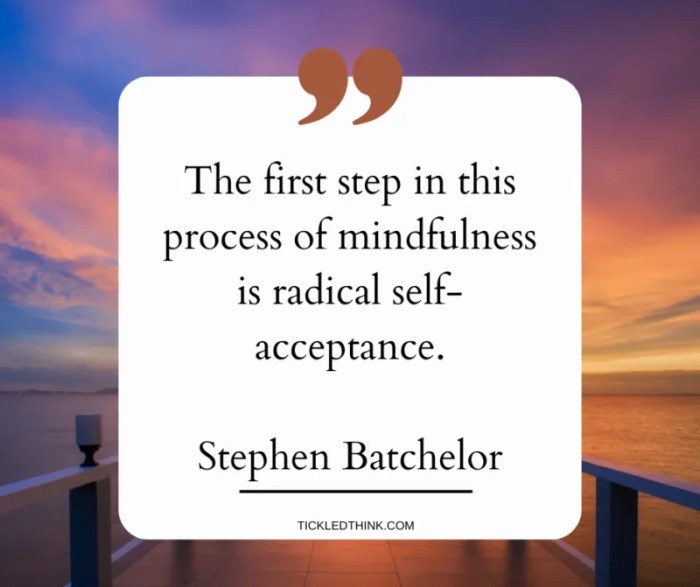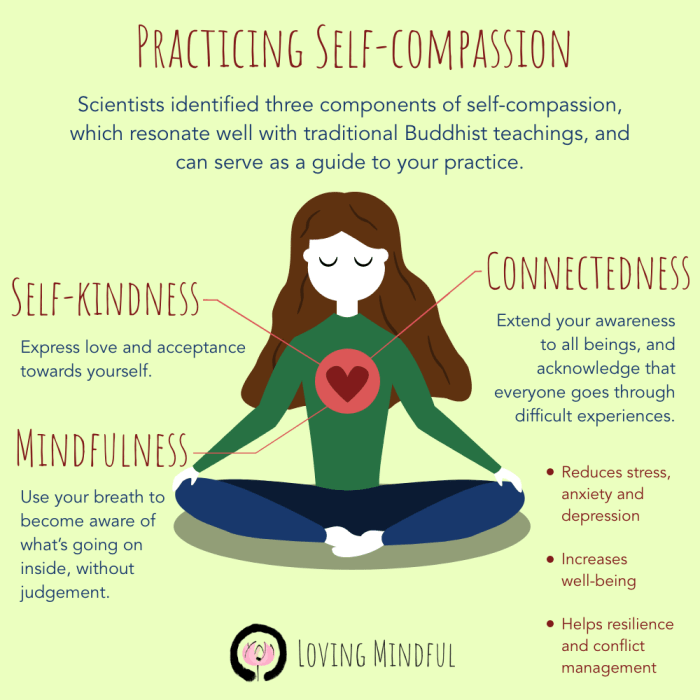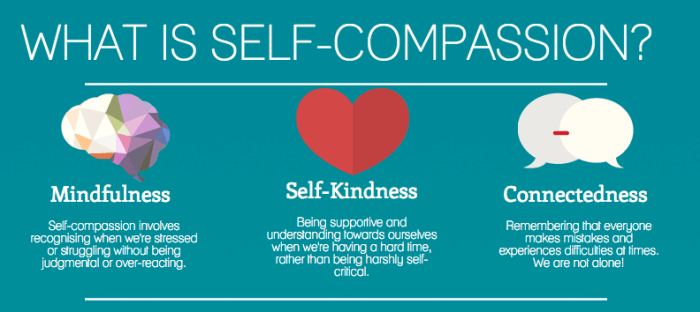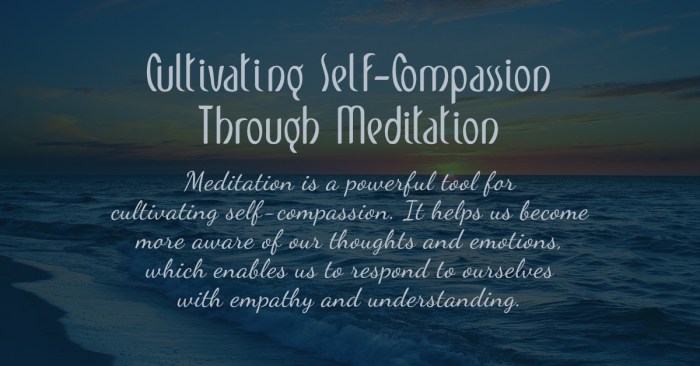How to Meditate for Building Self-Compassion and Acceptance takes center stage, inviting readers into a world of self-discovery and acceptance. In this guide, we explore the transformative power of meditation in fostering compassion and embracing acceptance.
From defining self-compassion to practical techniques for cultivating it, this comprehensive overview will equip you with the tools needed to embark on a journey of self-reflection and growth.
Introduction to Meditation for Self-Compassion and Acceptance

Self-compassion refers to the ability to show kindness, understanding, and forgiveness to oneself, especially in times of struggle or failure. Acceptance, on the other hand, involves acknowledging one’s thoughts, emotions, and experiences without judgment or resistance. Meditation is a powerful tool that can help individuals cultivate self-compassion and acceptance by promoting awareness, emotional regulation, and a sense of interconnectedness.
If you’re looking to unwind and relax after a long day, meditation can be a great tool to help you de-stress. Try techniques like body scan meditation or loving-kindness meditation to promote relaxation. For more information on meditating for unwinding and relaxing after a long day, visit this comprehensive guide on How to Meditate for Unwinding and Relaxing After a Long Day.
Benefits of Meditation for Building Self-Compassion and Acceptance
- Meditation allows individuals to observe their thoughts and feelings without getting caught up in them, fostering a sense of detachment and perspective.
- By practicing mindfulness meditation, individuals can develop a non-judgmental attitude towards their inner experiences, promoting self-compassion and self-acceptance.
- Regular meditation practice can increase self-awareness, leading to a deeper understanding of one’s emotions and behaviors, which is essential for cultivating self-compassion.
- Meditation helps individuals develop a sense of equanimity, enabling them to face challenging situations with more resilience and self-compassion.
Connection Between Mindfulness Meditation and Self-Compassion
- Mindfulness meditation involves paying attention to the present moment without judgment, which can help individuals become more aware of their inner experiences and develop self-compassion.
- Through mindfulness meditation, individuals can learn to approach their thoughts and emotions with curiosity and kindness, creating a supportive inner environment for self-compassion to flourish.
- Research has shown that mindfulness meditation can increase self-compassion by reducing self-criticism and enhancing self-kindness, leading to greater acceptance of oneself and others.
Getting Started with Meditation

Meditation can be a powerful tool for cultivating self-compassion and acceptance. To begin your meditation practice, it is essential to create a suitable environment, adopt the right posture, and focus on your breathing techniques. Consistency in your practice is also key to reaping the benefits of meditation.
Suitable Environment for Meditation
Find a quiet and peaceful space where you can meditate without distractions. This could be a corner of your room, a cozy spot in nature, or any place where you feel comfortable and at ease. Dimming the lights, playing soft music, or lighting a candle can also help create a calming atmosphere for meditation.
Sitting Posture and Breathing Techniques for Beginners
When starting your meditation practice, sit in a comfortable position with your back straight and shoulders relaxed. You can sit cross-legged on a cushion or chair, whichever is more comfortable for you. Place your hands on your lap or knees, palms facing up or down, and close your eyes gently.
For those seeking physical healing through meditation, there are specific techniques that can aid in the process. Practices like visualization meditation or yoga nidra can be beneficial for promoting physical well-being. To explore more techniques on how to meditate for physical healing, refer to this insightful article on How to Meditate for Physical Healing: 6 Techniques.
- Focus on your breath as you inhale deeply through your nose, allowing your abdomen to expand. Then exhale slowly through your mouth, feeling your abdomen contract. Repeat this deep breathing pattern to help calm your mind and body.
- Notice any thoughts or emotions that arise during your meditation practice, but gently let them go and return your focus to your breath. Remember, the goal is not to stop your thoughts but to observe them without judgment.
- Practice mindfulness by bringing your awareness to the present moment. Notice the sensations in your body, sounds around you, and the rhythm of your breath. This can help you stay grounded and centered during meditation.
Importance of Consistency in Meditation Practice
Consistency is key when it comes to meditation. Aim to set aside a few minutes each day to practice meditation, whether it’s in the morning, during a break at work, or before bed. Regular practice can help you build a strong foundation for self-compassion and acceptance, allowing you to cultivate a sense of inner peace and well-being over time.
When it comes to meditating for better focus during meditation, it’s essential to find a quiet space where you won’t be disturbed. Try techniques like mindfulness meditation or focusing on your breath to improve concentration. For more tips on enhancing your focus during meditation, check out this helpful guide on How to Meditate for Better Focus During Meditation.
Techniques for Cultivating Self-Compassion: How To Meditate For Building Self-Compassion And Acceptance

Self-compassion is a crucial aspect of meditation practice, helping individuals develop kindness and understanding towards themselves. Here are some techniques to cultivate self-compassion during meditation:
Loving-Kindness Meditation
- Loving-kindness meditation, also known as Metta meditation, involves sending love, kindness, and compassion to oneself and others.
- Start by sitting comfortably and focusing on your breath. Then, repeat phrases such as “May I be happy, may I be healthy, may I be safe, may I live with ease” while visualizing yourself surrounded by love and light.
- This practice helps in cultivating feelings of warmth and care towards oneself, fostering self-compassion and acceptance.
Using Positive Affirmations
- Positive affirmations are powerful tools to rewire negative thought patterns and cultivate self-compassion.
- During meditation, incorporate positive affirmations such as “I am worthy of love and kindness,” “I forgive myself for past mistakes,” or “I am enough just as I am.”
- Repeat these affirmations gently and with conviction, allowing yourself to internalize the positive messages and nurture self-compassion.
Guided Meditation Practices
- Guided meditations focused on self-compassion can be beneficial for those beginning their practice or seeking additional support.
- Listen to guided meditations that specifically target self-compassion, offering soothing guidance and prompts to cultivate kindness towards oneself.
- These meditations often include visualization exercises, breathing techniques, and affirmations to help individuals develop a sense of compassion and acceptance towards themselves.
Practices for Fostering Acceptance

In the practice of meditation for self-compassion and acceptance, fostering acceptance is a crucial aspect that allows individuals to let go of self-judgment and embrace themselves and others with kindness and understanding.
Concept of Radical Acceptance in Meditation
Radical acceptance involves fully acknowledging and embracing reality as it is, without resistance or judgment.
- During meditation, practitioners are encouraged to cultivate radical acceptance by acknowledging their thoughts, emotions, and sensations without trying to change or control them.
- This practice promotes a sense of inner peace and compassion towards oneself, fostering a deeper connection with one’s true self.
Mindfulness Exercises for Acceptance
- Body Scan Meditation: This exercise involves focusing on different parts of the body, observing sensations without judgment, and accepting them as they are.
- Loving-Kindness Meditation: Practitioners extend feelings of love, compassion, and acceptance towards themselves and others, fostering a sense of interconnectedness and understanding.
Techniques to Let Go of Self-Judgment
- Labeling Thoughts: Instead of getting caught up in self-critical thoughts, practitioners can label them as “thinking” and gently redirect their focus back to the present moment.
- Breath Awareness: By focusing on the breath, individuals can cultivate a sense of calm and presence, allowing them to let go of self-judgment and embrace acceptance.
Overcoming Challenges in Meditation for Self-Compassion and Acceptance

Meditation for self-compassion and acceptance can be a transformative practice, but it is not without its challenges. Distractions, wandering thoughts, and inner resistance are common obstacles that practitioners may encounter. However, with the right strategies and mindset, these challenges can be overcome to deepen the practice and cultivate a greater sense of self-compassion and acceptance.
Handling Distractions and Wandering Thoughts, How to Meditate for Building Self-Compassion and Acceptance
Distractions and wandering thoughts are natural occurrences during meditation. It’s essential to approach them with gentleness and understanding, rather than frustration. One effective strategy is to acknowledge the distraction without judgment and gently guide your focus back to your breath or chosen point of concentration. This practice of coming back to the present moment can help train the mind to be more focused and resilient against distractions.
The Role of Self-Compassion in Dealing with Challenges
Self-compassion plays a crucial role in navigating challenges during meditation. Instead of berating yourself for getting distracted or feeling resistance, practice self-compassion by offering yourself kindness and understanding. Treat yourself as you would a dear friend facing similar challenges, with patience and compassion. This approach can help you build a healthier relationship with yourself and cultivate a sense of acceptance for whatever arises during meditation.
Embark on your mindfulness journey towards self-compassion and acceptance with the knowledge and practices shared in this guide. May your meditation practice be a source of peace, understanding, and self-love as you navigate life’s challenges with grace and compassion.